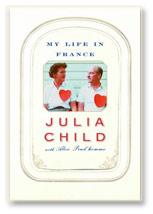Books |
Julia Child: My Life in France
By
Published: Aug 31, 2016
Category:
Food and Wine
Julia Child would be 104, so it’s understandable that, for many Americans, she looks and acts like Meryl Streep in the Nora Ephron film that burnished her eccentricities. But in the wayback machine, you can find the real Julia, teaching her fellow citizens the joy of French cooking on public television — a frowsy, big-boned (6’2", 158 pounds) matron with a trill in her voice, hacking up a chicken with more zest than is called for, most likely because she’s been chugging the cooking sherry.
My favorite way of considering Julia Child — the Julia Child of "My Life in France" — is as a revolutionary. Not intentionally. She just had the great good fortune to find herself living in Paris with no job and nothing more compelling than a tentative interest in cooking. She signed up for classes at Cordon Bleu, got hooked, and with two friends was soon working on a book we now take for granted but was then unimagined — an authoritative guide to French cooking for Americans.
Published 55 years ago, ‘Mastering the Art of French Cooking, Volume One’ has never gone out of print. It never will. It is the gold standard. [To buy the cookbook from Amazon, click here. For the Kindle edition, click here.]
Of her 11 books, none was a memoir. But she kept scribbles and letters, and at the end of her life, she began to shape this book with her grandnephew. Like almost everything she touched, ‘My Life in France’ is a triumph — insightful, poetic, deadly accurate about people, and, above all, tasty. Reading it, you breathe French air. [To buy the paperback from Amazon, click here. For the Kindle edition, click here.]
Nothing in her early life would have predicted that Julia Child would become formidable in any way. Her father was a conservative Southern California businessman; her mother was "warm and social." After college came World War II and government work in Ceylon. There she met Paul Child, an artist who designed ‘war rooms’ for the generals. The first meal she cooked for him — brains simmered in red wine — was not a success. Still, they married, and, in 1948, moved to France. She was 36. She didn’t speak a word of French.
Her first meal, in Rouen, started with oysters, served with a pale rye bread and unsalted butter. They were followed by sole meuniere, "perfectly browned in a sputtering butter sauce with a sprinkling of chopped parsley." Mr. and Mrs. Child washed it down with a bottle of Pouilly-Fume. They moved on to a green salad and a baguette, fromage blanc and cafe filtre. "Absolute perfection," Julia decided. "The most exciting meal of my life."
Fortunately, the Childs were not rich — two-star restaurants were the best they could afford in Paris. But Julia was reading cookbooks, making friends in the food markets, falling in love with Paris. At Cordon Bleu, her classmates were 11 former American servicemen who were studying courtesy of the GI Bill of Rights. She went right to the head of the class.
To read this book is to peer over her shoulder and learn with her. Scrambled eggs, for example. They are not whipped, just gently blended. Smear the pan with butter, add the eggs, salt and pepper, cook over a low flame. After about three minutes, the eggs will start to form a custard. Only then do you stir rapidly with a fork, sliding the pan on and off the burner. Pull the egg curds together — and, finally, add more butter, to "stop the cooking." Sprinkle with parsley (or not). Serve. Dazzle.
The real revelations in this book are not about food, however — they’re about work. There’s a lot of it involved in the creation of a book, especially when you’re creating something new. "WHY DID WE EVER DECIDE TO DO THIS ANYWAY?" Julia writes to one of her collaborators. But after eight years, the thing is done. And Knopf offers to buy it for $1,500. The galleys weigh 15 pounds. When printed, it is 732 pages long.
In 1961, when ‘Mastering the Art of French Cooking’ was published, Paul Child was 59 years old. Julia was 49. They had no expectations of a bestseller, much less a franchise. But the New York Times raved — the recipes are "painstakingly edited and written as if each were a masterpiece, and most of them are" — and the appearance on the "Today" show went well. The book sold and sold. In 1962, Julia taped three half-hour shows for WGBH, the public TV station in Boston. By the following year, she had taped 26 more.
But this is not a celebrity memoir. This book is called "My Life in France" for a reason — it is there that Julia and Paul feel most fully alive. Paul’s photographs deliver the country in delicious slivers. The passages at their home in the South of France lift off the page and surround you. You inhale lavender. You feel the breeze. In the distance is the smell of lamb cooking in herbs. There is laughter, and wit, and, most of all, blessed silence. If this is not a description of Heaven, what is?
Paul takes ill and dies. Julia soldiers on. She understands — you have to keep grabbing life. Food and love and very shrewd French friends have taught her well: "Nothing is too much trouble if it turns out the way it should."
The book ends this way: "The pleasures of the table, and of life, are infinite — toujours bon appetit!" As you read these words, you finally get it — this is not a book about food, this is a book about life. A wise life, a life of beauty, art and invention. You can learn a lot from a life like that.
Start with this book.


